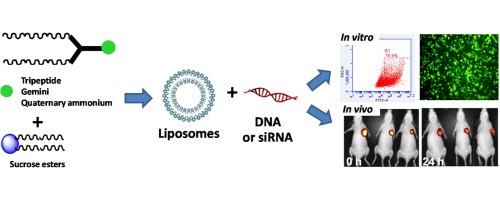Mempro™ Cationic Liposomes
The advanced Mempro™ Cationic Liposomes have been widely used in drug delivery and gene delivery which can be custom prepared by Creative Biostructure.
 Figure 1. The cationic lipsomes containing sucrose ester are used as helper lipid to efficiently transfer DNA or siRNA into tumor cells and tumor tissues of mice with low toxicity both in vitro and in vivo. (K. Aramaki, et al., 2016)
Figure 1. The cationic lipsomes containing sucrose ester are used as helper lipid to efficiently transfer DNA or siRNA into tumor cells and tumor tissues of mice with low toxicity both in vitro and in vivo. (K. Aramaki, et al., 2016)
The development of novel efficient and safe vehicles for gene delivery has great effect on the success of gene therapy. Viral and non-viral vehicles have been recently applied to transport genes into cells. Compared to other delivery vehicles, non-viral vehicles has a lot of advantages since they are safer and more stable, have greater capacity and unlimited size, easy to perform large-scale production, and have great potential to incorporate targeting ligands. Mempro™ Cationic Liposomes are able to improve the transfection efficiency among those non-viral vehicles.
Mempro™ Cationic Liposomes are composed of various phospholipids, and their typical bilayer formation is the structural basis to improve the gene delivery efficacy. Neutrally lipids such as DOPC, DOPE and cholesterol are usually considered as helper lipids to use together with cationic lipids. The helper lipids play a crucial role in combining cationic liposomes with genes to form lipoplexes because morphologies of these lipoplexes are determined by them.
Mempro™ Cationic Liposomes are under extensive research for medical and biological applications due to their positive charged surfaces, which enhance the celluar uptake of encapsulated drugs or biomolecules. One major drawbacks of cationic molecules is the cytotoxicity. In order to overcome this barrier, we can reduce the content of cationic molecules and contribute their positive charge by incorporating them into Mempro™ Cationic Liposomes. In addition, cholesterol is a widely used lipid mixed in liposomes, and it is an important constituent of the cell membrane because the unique ability to change fluidity of the cell membrane and regulate material transport acroos the cell membrane. Though cholesterol is not an ionic lipid, it might have effect on the dissociation of cationic liposome membrane by conformational changes of the cationic head group area. Mempro™ Cationic Liposomes also increase the zeta potential sometimes.
Wrapping magnetite nanoparticles into cationic liposomes provides another promising method for gene delivery. The magnetic targeting is non-invasive which can direct and accumulate loaded therapeutic genes in tumor cells or tissues under a condition of an external magnetic field. Moreover, magnetic cationic liposomes are very attractive and useful in cancer therapy such as heating mediators and magnetic resonance imaging as contrast agents.
Besides Mempro™ Cationic Liposomes, Creative Biostructure also provides other novel functional liposomes. Please feel free to contact us for a detailed quote.
References:
K. Aramaki, et al. (2016). Charge boosting effect of cholesterol on cationic liposomes. Colloids and Surfaces A: Physicochem. Eng. Aspects, 506: 732–738.
Y. Zhao, et al. (2016). Sucrose ester based cationic liposomes as effective non-viral gene vectors for gene delivery. Colloids and Surfaces B: Biointerfaces, 145: 454–461.
A. M. Galvão, et al. (2016). Cationic liposomes containing antioxidants reduces pulmonary injury in experimental model of sepsis liposomes antioxidants reduces pulmonary damage. Respiratory Physiology & Neurobiology, 231:55–62.